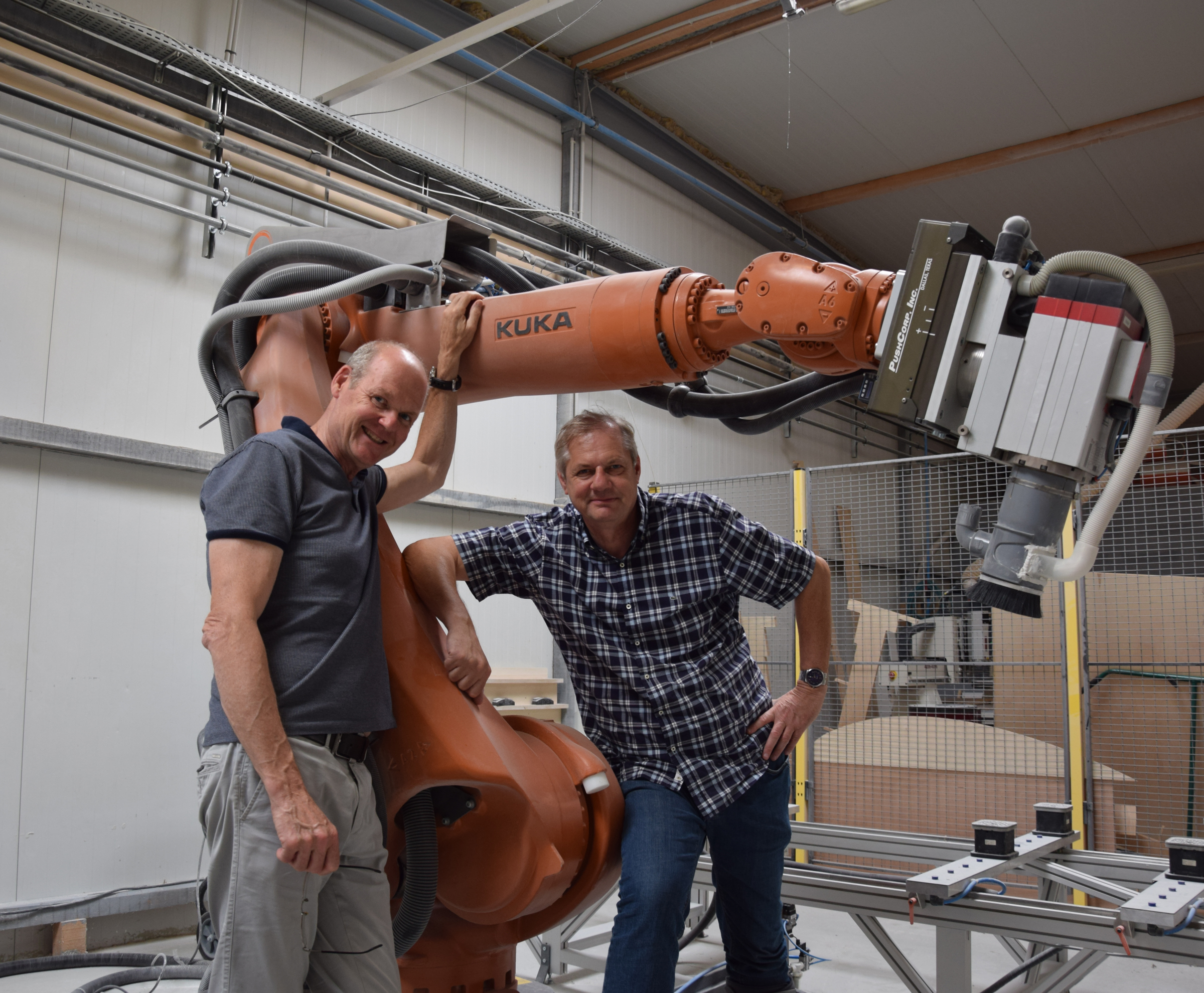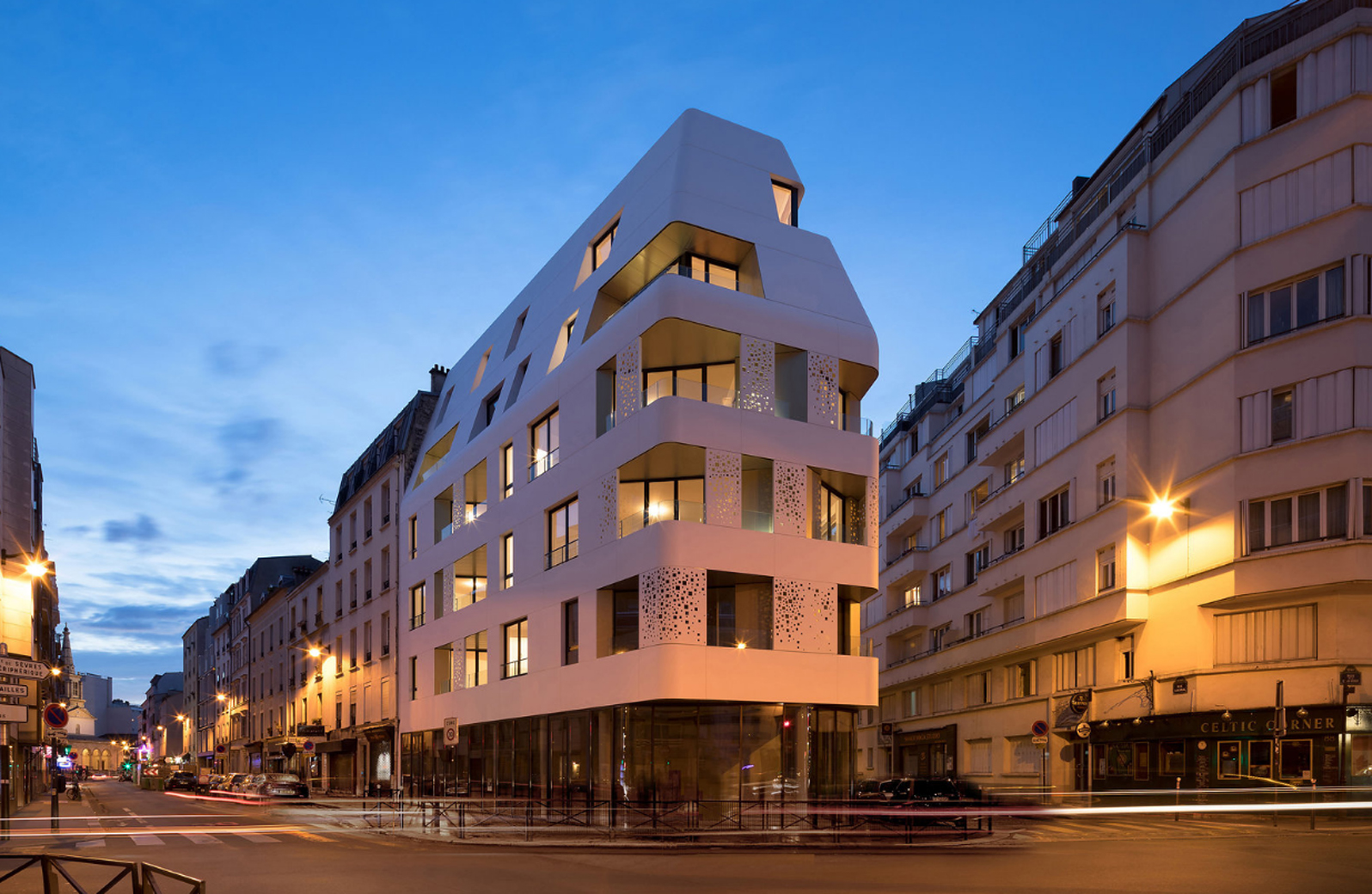Member Spotlight - Créa Diffusion
Member Since 1999
Renowned Fabricator Tackles Amazing Building Facade Project in Paris
by Kevin Cole, Editor
Few would disagree that Créa Diffusion is among the most innovative solid surface fabricators in the world, having handled numerous difficult, unique and high-profile projects. A past ISFA Fabricator of the Year, the company, based in Sologne, France even has their work featured in the historical Palace of Versailles, which was the principal residence of the kings of France from Louis XIV in 1682 until the beginning of the French Revolution in 1789.
With a 3,000-sq.-meter (more than 32,000-sq.-ft.) facility, there is virtually no job the company cannot handle, working primarily with Corian® Solid Surface. And, it once again proved this with an amazing cladding project of a building in downtown Paris in the district of the Cross Nivert. The five-story building, which houses two businesses and 10 residential units, was clad in Glacier White Corian . While this certainly isn’t the first time solid surface has been used to clad the exterior of a building, and not even the first time Créa Diffusion has done so, this project was filled with challenges including 2-D sheets and 3-D thermoformed portions with intricate cutouts.
However, before getting into the complexities of the project, it’s important to understand the background of the company and its capabilities.
History
 Créa Diffusion was founded in 1988 under the initiative of Thierry and Laurent Delles, who were trained carpenters, and was first housed in their father’s old workshop in Rémilly, France. After three years of building up the business and laying a solid foundation, they began looking for a way to differentiate the company to make it more dynamic and allow for sustainable growth. That led to their discovery of Corian, and solid surface would prove to be the factor that revolutionized their business. Créa Diffusion was founded in 1988 under the initiative of Thierry and Laurent Delles, who were trained carpenters, and was first housed in their father’s old workshop in Rémilly, France. After three years of building up the business and laying a solid foundation, they began looking for a way to differentiate the company to make it more dynamic and allow for sustainable growth. That led to their discovery of Corian, and solid surface would prove to be the factor that revolutionized their business.
They were so enamored by the product that over time the use of wood in projects gradually declined until they began to specialize purely in solid surface, using only wood as an ancillary product. The change paid off in a big way, and the company grew steadily by 15 percent a year, although in the beginning the majority of the work done was standard kitchen jobs. Corian, which had previously been little known, soon got a reputation as a great surfacing material throughout the Metz region of France, and the company grew to more than 10 employees.
As the qualities of solid surface became more well-known, the healthcare industry began to show interest. A material that was virtually seamless, hygienic and easily maintained, while also being nonporous so as to resist staining, etching, etc., was very compatible with hospitals and such, and growth in that area led the company to the national stage.
The brothers pushed on, and soon were collaborating with well-known, high-end designers, further increasing their growth and recognition.
But, by 2002, they were experiencing growing pains and their facility just wasn’t large enough to handle all of the equipment they needed to continue their march forward. As such, they moved to a new building in Sologne where their facility remains today, and were able to bring in a variety of machinery to continue to advance their capabilities and competencies.
Capabilities
Along with the physical growth, they were now afforded the ability to bring in plenty of equipment. They currently have three digital machining centers that allow them to nest and cut parts, engrave in either 2-D or 3-D, and create molds and prototypes for advanced projects. They also have a v-grooving machine that can be used for high production countertop operations, a 3-D printer that allows direct printing of parts for prototypes from the company’s design or to allow evaluating visual renderings, and a six-axis robot that can perform sanding and finishing processes for high-volume jobs.
Créa Diffusion also has very advanced thermoforming capabilities, including three vacuum membrane thermoforming presses with four thermoforming ovens, five hydraulic presses ranging from 30 to 160 tons and a ThermoLine® press. According to Thierry, the membrane presses are used to thermoform Corian under a vacuum, but their capacity is limited, making them suitable for development of prototypes or very small series, but also allowing for making less expensive molds. The hydraulic presses, depending on the size, are used to make bowls, stamp the company’s CREATO line of washbasins directly into sheets, and produce large 3-D panels. The ThermoLine press is a production line developed to allow thermoforming in large series at high production levels.
It takes plenty of know-how and manpower to be able to operate all of the equipment and keep up with the demand for their skills. So, in addition to Thierry, who is sort of the frontman for the company and Laurent who manages the shop, the company also has three project managers that work on project development and site monitoring, two designers to handle product layout and manufacturing, and numerous machine operators, personnel to manufacture custom parts and others to make series parts and sanders. Additionally, Créa Diffusion has eight separate installation teams to handle the installation of the works throughout France. Altogether, the company employs 60 skilled tradesmen.
The Cross Nivert Building Facade
So with an understanding of just what the company is capable of, one can begin to look at the awe-inspiring cladding project in downtown Paris. However to be able to show off the company’s skills, the project first had to be landed.
“The façade market is new for solid surface,” explained Thierry Delles. “There is a huge volume to sell, but it is not easy. Also there are specific rules to respect when using the material outside. You have to deal with parameters like weather and temperature.”
The story began when Frédéric Nakache a principle architect of Nakache & Orihuela Architects (NOA) contacted Créa Diffusion to find out more about solid surface and if it might work for the project. “When I saw the first drawing I thought, ‘Whoa!!! How could I make that?’” he said. “But after this meeting, when I was on the fast train back my office, I was very excited by what I had seen. It was very complex and very interesting, and I wanted to talk to my staff about how we could accomplish it.”
After discussing it with the team, they had worked out the technical challenges of the project: The size of the project and hanging such large pieces of solid surface; combining 2-D and 3-D thermoforming with CNC-machined pieces; and creating a system to hang the sheets in such a way as they didn’t actually touch the building, yet covered it and were stable. Additionally, they had to be very price-conscious because there was another European company they were bidding against who offered a different material, but was also known for its skill in carrying out such complex projects.
Once they had the idea of how to accomplish the task, Thierry Delles invited Nakache to the company’s facility to show him what the company could do. “I invited the architect to visit our shop to tour our facilities, but it is difficult to get architects to come to our little town in the east of France, near the German border,” he said. “But he came and while we don’t have a showroom, we have a lot of prototypes from other intricate projects in our warehouse, and what we showed him was like crossing 30 years of experience with Corian.”
After seeing the previous creative work, Nakache was reassured and signed the contract for the project. Then, it became a matter of realizing it.
“My brother Laurent started to manage the work with his workshop chief Thierry Hoffmann, making an accurate layout, the different molds, the cutting and machining designs on our software and so on,” explained Thierry Delles. “The cladding installation was managed by Paul-Marie Meillerand and our chief-installer for 15 years who is a “compagnon du tour de France” (a designation for one of the best craftsman in the country), and the first job was to fix the material to the rails of the aluminum structure, which had to be plumbed perfect to the concrete wall made by the general contractor to avoid problems.”
“Another point with the sheets was to coordinate the square and vertical holes so that the rails weren’t visible from the interior,” he continued. “Our solution was to hang the sheet on vertical stainless steel cables. We were playing with a 1 millimeter of gap to hang the hooks into the rails, but were able to get it done.”
The result was an iceberg-like structure with approximately 800 sq. meters (more than 8,600 sq. ft.) of Glacier White Corian, as the architect envisioned. The white Solid Surface is perforated according to the orientation of the views and the sunshine of the intersection giving tenants both a beautiful view and the intimacy of a home space (see Figure 5). The use of solid surface as an envelope material not only put forth a bold statement, but also improved the building’s ease of maintenance, ensuring its durability over time.
“The final result was even more spectacular than what we had in our mind starting this work,” said Thierry Delles. “The streets in front of the building are in a busy neighborhood, and people would stop and watch the work and take photos. Our team felt great making something new and innovative that was appreciated by everyday people who didn’t necessarily have technical minds.”
For more information on Créa Diffusion visit www.crea-diffusion.com. For more information on Nakache & Orihuela Architects visit www.noa.fr.
|